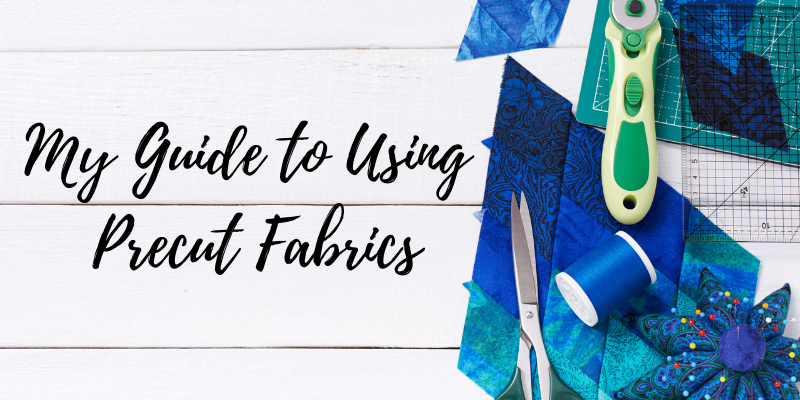Whether you love precuts for the fabric variety, the convenience of not having to cut every piece of fabric, or the speed and ease of piecing quilts, precuts have a lot to offer! Simply put, precuts let you skip a lot of cutting and jump right into sewing. Some people prefer the long, lanky strips or the super-efficient five and 10-inch squares. Either way, precuts can make your quilting life a little better.
Here’s what I know about precut fabrics.
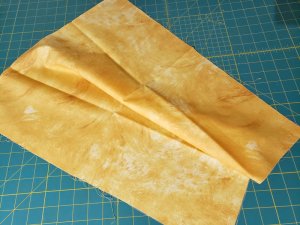 Fat Quarters are typically folded and sold individually or packaged in small to large bundles. Measuring 18″ x 21″ (including selvage), many people will say that fat quarters win the precut popularity contest. The term fat comes from the quarter-yard cut that offers more width than a traditional quarter yard that measures 9″ wide x 42″ long (the full unfolded width of fabric, or WOF).
Fat Quarters are typically folded and sold individually or packaged in small to large bundles. Measuring 18″ x 21″ (including selvage), many people will say that fat quarters win the precut popularity contest. The term fat comes from the quarter-yard cut that offers more width than a traditional quarter yard that measures 9″ wide x 42″ long (the full unfolded width of fabric, or WOF).
From one fat quarter you can cut 12–5″ squares, 20–4″ squares, 42–3″ squares 56–2.5″ squares or 90—2″ squares.
Fat Eighths are 9″ wide x 21″ (exactly half the size of a fat quarter). These are typically only sold in bundles.
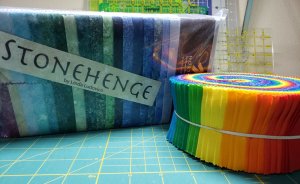 Strips are typically 2.5″ wide x 42″ (WOF) and different manufacturers have different names for them. Typically, they’re called jelly rolls and a top choice for many quilters. Many strips come rolled in a “jelly roll” style and are most often seen with two pieces each of 20 different prints in the fabric designer’s collection. Jelly roll strips have different names that vary by manufacturer. For example, “Bali pops,” “role polies,” “roll-ups,” “design rolls,” or merely “strips” are all referring to the same 42–2.5″ x WOF fabric pieces. “Honeybuns” are strip sets measuring 1.5″ wide x WOF. Some manufacturers package their strips flat, not rolled, and call them “strips or “jolly bars.”
Strips are typically 2.5″ wide x 42″ (WOF) and different manufacturers have different names for them. Typically, they’re called jelly rolls and a top choice for many quilters. Many strips come rolled in a “jelly roll” style and are most often seen with two pieces each of 20 different prints in the fabric designer’s collection. Jelly roll strips have different names that vary by manufacturer. For example, “Bali pops,” “role polies,” “roll-ups,” “design rolls,” or merely “strips” are all referring to the same 42–2.5″ x WOF fabric pieces. “Honeybuns” are strip sets measuring 1.5″ wide x WOF. Some manufacturers package their strips flat, not rolled, and call them “strips or “jolly bars.”
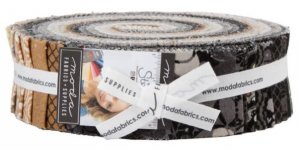 With one jelly roll, you can bind five twin-size quilts, four queen-size quilts or three king-size quilts. The same roll will yield 640–2.5″ squares, 440–45-degree diamonds or 1,080 equilateral triangles that finish 1.75″ high.
With one jelly roll, you can bind five twin-size quilts, four queen-size quilts or three king-size quilts. The same roll will yield 640–2.5″ squares, 440–45-degree diamonds or 1,080 equilateral triangles that finish 1.75″ high.
To use strips from the center of a roll but keep the rest of the roll neat and tidy, carefully unroll the strips and secure the ends. Ease out the strips you want and then reroll the rest. Sometimes it’s the strips in the center you simply cannot wait to use!
 I made this blue and yellow quilt from a jelly roll plus navy and yellow floral yardage. It was a charity quilt that was auctioned to raise money for Toys for Tots. The primary part of the pattern was from a video I watched on Missouri Star’s YouTube channel and the pattern is called “summer camp.”
I made this blue and yellow quilt from a jelly roll plus navy and yellow floral yardage. It was a charity quilt that was auctioned to raise money for Toys for Tots. The primary part of the pattern was from a video I watched on Missouri Star’s YouTube channel and the pattern is called “summer camp.”
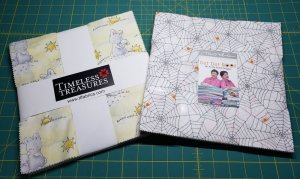 Squares commonly come in 2.5″ and 5″ (known as “mini charm” and “charm squares,” or “candy,” respectively), and also in 10-inch “layer cakes” or “stackers,” bundles. Many times the precut squares come with pinked edges and each package contains an average of 40 pieces with the prints repeated two or three times. These precuts are great for table runners, baby, quilts, prairie points, charm quilts, charity quilts and also to begin teaching children to quilt.
Squares commonly come in 2.5″ and 5″ (known as “mini charm” and “charm squares,” or “candy,” respectively), and also in 10-inch “layer cakes” or “stackers,” bundles. Many times the precut squares come with pinked edges and each package contains an average of 40 pieces with the prints repeated two or three times. These precuts are great for table runners, baby, quilts, prairie points, charm quilts, charity quilts and also to begin teaching children to quilt.
The edges are pinked to prevent fraying. Use the outermost edge of the pinking to gauge your seam allowance. If you choose to trim the pinked edges just make sure you still have enough fabric to complete your specific project.
 I made this tulip quilt from a package of five-inch charms. The pattern is called “totally tulips” and can also be found in Missouri Star’s video library. The purple backing has a marbled look.
I made this tulip quilt from a package of five-inch charms. The pattern is called “totally tulips” and can also be found in Missouri Star’s video library. The purple backing has a marbled look.

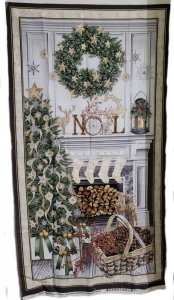 Panels are a precut many people overlook in the precut category. Panels are typically 23″-24″ x 42″-44″ and can be either horizontal or vertical in orientation. Panels are printed with either a single design, like the Noel panel from Timeless Treasures (shown here), or have several designs that can be cut apart and used as quilt squares, pillows, placemats or other home decor projects, as shown here in the old flower trucks example, by Moda Fabrics. (Click on each image to enlarge it.)
Panels are a precut many people overlook in the precut category. Panels are typically 23″-24″ x 42″-44″ and can be either horizontal or vertical in orientation. Panels are printed with either a single design, like the Noel panel from Timeless Treasures (shown here), or have several designs that can be cut apart and used as quilt squares, pillows, placemats or other home decor projects, as shown here in the old flower trucks example, by Moda Fabrics. (Click on each image to enlarge it.)
Some quilters use panels as a center quilt motif with other coordinating fabrics in a variety of designs to “frame” the panel or as wall hangings. In my experience, panels are never square and require some precise trimming to make them useable.
 I created the fall leaves quilt, shown here, with a panel as a center motif. I did hand outline embroidery with three strands of thread around the words, parts of the bicycle and some of the leaves to make the panel both visually pop and add texture. All the fabrics in the pieced area of the border feature metallic accents and are from a fall collection from RJR Fabrics. This pattern was my own design.
I created the fall leaves quilt, shown here, with a panel as a center motif. I did hand outline embroidery with three strands of thread around the words, parts of the bicycle and some of the leaves to make the panel both visually pop and add texture. All the fabrics in the pieced area of the border feature metallic accents and are from a fall collection from RJR Fabrics. This pattern was my own design.
Prewashing precut fabric is a common topic in social media quilting groups. The answer, in my opinion, is an emphatic, no. Don’t prewash precuts as it can cause the fabric pieces to stretch out of shape and fray, making them much more difficult to cut and sew with.
If you’re worried about color bleed, or colorfastness, I highly recommend laundering the completed project with Shout Color Catchers. In my experience, one or two color catchers do the job. However, if you see color bleed after washing then rewash with two or three more color catchers. Do not put your quilt in the dryer until you know that no more bleeding is occurring. Most quilts only require one washing.
However, I made one queen-sized quilt (it had a lot of red fabric) that I washed four times before it finally went into the dryer. I think I used a dozen Color Catchers before the last wash came out clear. Once you dry a quilt in the dryer, any bleed or fading will be locked into the fabric by the dryer’s heat and now forever part of your quilt. This is only one of two quilts, of more than 50 I’ve made, that needed more than one washing due to color fading. In my experience, good quality quilting fabric rarely fades. If fading occurs it’s typically fabric with a lot of color saturation from dark colors like red, black, navy blue, etc.
Pattern availability is another advantage to precut fabrics. The number of patterns for precuts available online is staggering. There are many fabric manufacturer websites with free patterns for precuts that are available for download. Also, there are a lot of quilt designers who have published books with patterns for precuts or patterns considered precut-friendly. Many of these same designers also sell individual patterns for precuts on their websites as PDF downloads. If you’re unsure of what to do with that jelly roll you just couldn’t pass up, inspiration is just a click or two away.
I just love the soft crinkle of a quilt that’s been in the dryer! The dryer also makes every tiny imperfection in the piecing and quitting completely invisible.
Happy, precut quilting!

